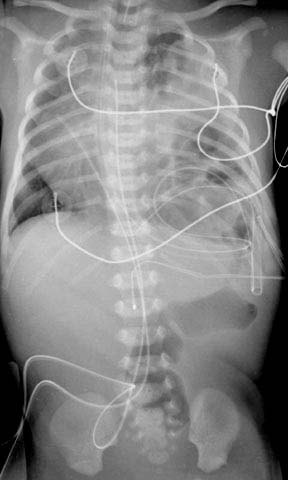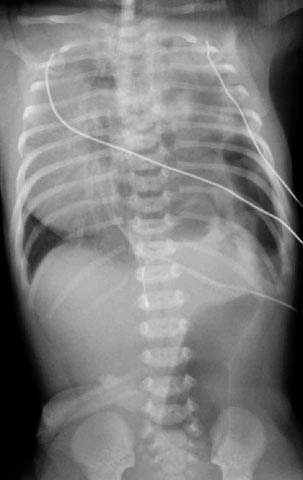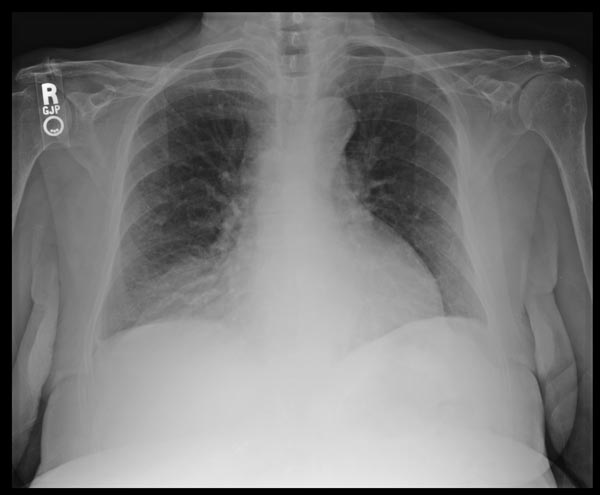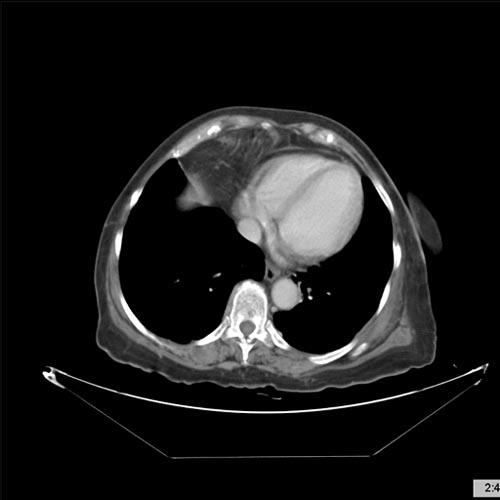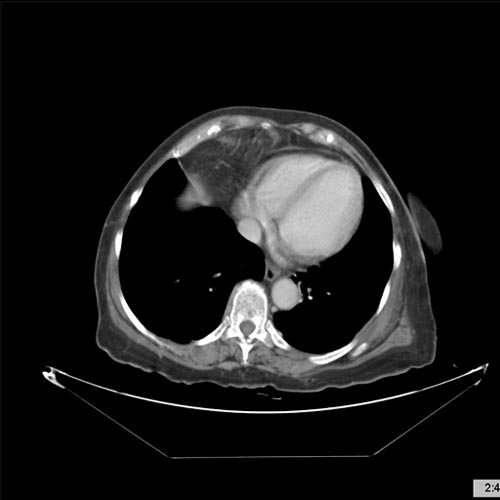Congenital diaphragmatic hernia: Difference between revisions
No edit summary |
|||
| Line 1: | Line 1: | ||
__NOTOC__ | |||
'''For patient information click [[{{PAGENAME}} (patient information)|here]]'''. | '''For patient information click [[{{PAGENAME}} (patient information)|here]]'''. | ||
{{SI}} | |||
{{CMG}} | {{CMG}} | ||
'''Associate Editor-In-Chief:''' {{CZ}} | '''Associate Editor-In-Chief:''' {{CZ}} | ||
==Overview== | ==Overview== | ||
| Line 20: | Line 18: | ||
DiseasesDB = 32489 | | DiseasesDB = 32489 | | ||
}} | }} | ||
'''Congenital diaphragmatic hernia''' ([[CDH]]) is a term applied to a variety of [[congenital disorder|congenital birth defects]] that involve abnormal development of the [[diaphragm (anatomy)|diaphragm]]. The term is used most commonly in reference to Bochdalek hernia, however it can also apply to '''[[Morgagni's hernia]]''', '''[[diaphragm eventration]]''' and '''[[central tendon defects]]''' of the diaphragm. A common theme in all scenarios is malformation of the diaphragm; this allows the [[abdomen|abdominal]] contents to protrude into the [[chest]] thereby impeding proper [[lung]] formation. Newborns with CDH often have severe [[respiratory distress]] which can be life-threatening unless treated appropriately. | '''Congenital diaphragmatic hernia''' ([[CDH]]) is a term applied to a variety of [[congenital disorder|congenital birth defects]] that involve abnormal development of the [[diaphragm (anatomy)|diaphragm]]. The term is used most commonly in reference to Bochdalek hernia, however it can also apply to '''[[Morgagni's hernia]]''', '''[[diaphragm eventration]]''' and '''[[central tendon defects]]''' of the diaphragm. A common theme in all scenarios is malformation of the diaphragm; this allows the [[abdomen|abdominal]] contents to protrude into the [[chest]] thereby impeding proper [[lung]] formation. Newborns with CDH often have severe [[respiratory distress]] which can be life-threatening unless treated appropriately. | ||
| Line 38: | Line 35: | ||
Survival rates for infants with this condition vary, but have generally been increasing through advances in neonatal medicine. Work has been done to correlate survival rates to ultrasound measurements of the lung volume as compared to the baby's head circumference. This figure known as the lung to head ratio (LHR) may be used to determine if fetal surgery may be used as an option. | Survival rates for infants with this condition vary, but have generally been increasing through advances in neonatal medicine. Work has been done to correlate survival rates to ultrasound measurements of the lung volume as compared to the baby's head circumference. This figure known as the lung to head ratio (LHR) may be used to determine if fetal surgery may be used as an option. | ||
<gallery> | |||
Image: | |||
Diaphragmatic-hernia-001.jpg | |||
Image: | |||
Diaphragmatic-hernia-002.jpg | |||
</gallery> | |||
===Treatment=== | ===Treatment=== | ||
Revision as of 17:32, 3 August 2012
For patient information click here.
Editor-In-Chief: C. Michael Gibson, M.S., M.D. [1] Associate Editor-In-Chief: Cafer Zorkun, M.D., Ph.D. [2]
Overview
Template:DiseaseDisorder infobox Congenital diaphragmatic hernia (CDH) is a term applied to a variety of congenital birth defects that involve abnormal development of the diaphragm. The term is used most commonly in reference to Bochdalek hernia, however it can also apply to Morgagni's hernia, diaphragm eventration and central tendon defects of the diaphragm. A common theme in all scenarios is malformation of the diaphragm; this allows the abdominal contents to protrude into the chest thereby impeding proper lung formation. Newborns with CDH often have severe respiratory distress which can be life-threatening unless treated appropriately.
Bochdalek Hernia
The Bochdalek hernia, also known as a postero-lateral diaphragmatic hernia, is the most common manifestation of CDH, accounting for more than 95% of cases.[1][2] In this instance the diaphragm abnormality is characterized by a hole in the postero-lateral corner of the diaphragm which allows passage of the abdominal viscera into the chest cavity. The majority of Bochdalek hernias (80-85%) occur on the left side of the diaphragm, a large proportion of the remaining cases occur on the right side, and a small fraction are bilateral i.e., left and right sided defects. [3][4]
Pathophysiology
It involves three major defects.
- A failure of the diaphragm to completely close during development.
- Herniation of the abdominal contents into the chest
- Pulmonary Hypoplasia
Presentation and Diagnosis
This condition can often be diagnosed before birth and fetal intervention can sometimes help, depending on the severity of the condition.[5] Infants born with diaphragmatic hernia experience respiratory failure due to both pulmonary hypertension and pulmonary hypoplasia. The first condition is a restriction of blood flow through the lungs thought to be caused by defects in the lung. Pulmonary hypoplasia or decreased lung volume is directly related to the abdominal organs presence in the chest cavity which causes the lungs to be severely undersized, especially on the side of the hernia.
Survival rates for infants with this condition vary, but have generally been increasing through advances in neonatal medicine. Work has been done to correlate survival rates to ultrasound measurements of the lung volume as compared to the baby's head circumference. This figure known as the lung to head ratio (LHR) may be used to determine if fetal surgery may be used as an option.
Treatment
ECMO has been used as part of the treatment strategy at some hospitals.[6][7]
Morgagni's Hernia
This rare anterior defect of the diaphragm is variably referred to as Morgagni’s, retrosternal, or parasternal hernia. Accounting for approximately 2% of all CDH cases, it is characterised by herniation through the foramina of Morgagni which are located immediately adjacent to the xyphoid process of the sternum.[8] The majority of hernias occur on the right side of the body and are generally asymptomatic. However, newborns may present with respiratory distress at birth similar to Bochdalek hernia. Additionally, recurrent chest infections and gastrointestinal symptoms have been reported in those with previously undiagnosed Morgagni's hernia.[9][10] In asymptomatic individuals laparoscopic surgical repair is still recommended as they are at risk of a strangulated intestine.
-
Mass adjacent to heart seen on routine pre-employment chest x-ray
-
CT Morgagni's Hernia
-
CT Morgagni's Hernia
Diaphragm Eventration
The diagnosis of congenital diaphragmatic eventration is used when there is abnormal displacement (i.e. elevation) of part or all of an otherwise intact diaphragm into the chest cavity. This rare type of CDH occurs because in the region of eventration the diaphragm is thinner, allowing the abdominal viscera to protrude upwards. This thinning is thought to occur because of incomplete muscularisation of the diaphragm, and can be found unilaterally or bilaterally. [11] Minor forms of diaphragm eventration are asymptomatic, however in severe cases infants will present with respiratory distress similar to Bochdalek hernia.[12] Diaphragm eventration is typically repaired thoracoscopically, by a technique called plication of the diaphragm. [13] Plication basically involves a folding of the eventrated diaphragm which is then sutured in order to “take up the slack” of the excess diaphragm tissue.
References
- ↑ Torfs CP, Curry CJ, Bateson TF, Honoré LH (1992). "A population-based study of congenital diaphragmatic hernia". Teratology. 46 (6): 555–65. doi:10.1002/tera.1420460605. PMID 1290156.
- ↑ Yang W, Carmichael SL, Harris JA, Shaw GM (2006). "Epidemiologic characteristics of congenital diaphragmatic hernia among 2.5 million California births, 1989-1997". Birth Defects Res. Part A Clin. Mol. Teratol. 76 (3): 170–4. doi:10.1002/bdra.20230. PMID 16511883.
- ↑ Torfs CP, Curry CJ, Bateson TF, Honoré LH (1992). "A population-based study of congenital diaphragmatic hernia". Teratology. 46 (6): 555–65. doi:10.1002/tera.1420460605. PMID 1290156.
- ↑ Lally KP, Lally PA, Lasky RE; et al. (2007). "Defect size determines survival in infants with congenital diaphragmatic hernia". Pediatrics. 120 (3): e651–7. doi:10.1542/peds.2006-3040. PMID 17766505.
- ↑ "Deadly hernia corrected in womb - Surgeons have developed an operation to repair a potentially fatal abnormality in babies before they are born". BBC news. 2004-07-26.
|access-date=requires|url=(help) - report of new operation, pioneered at London's King's College Hospital which reduced death rates in the most at risk by 50% - ↑ Tiruvoipati R, Vinogradova Y, Faulkner G, Sosnowski AW, Firmin RK, Peek GJ (2007). "Predictors of outcome in patients with congenital diaphragmatic hernia requiring extracorporeal membrane oxygenation". J. Pediatr. Surg. 42 (8): 1345–50. doi:10.1016/j.jpedsurg.2007.03.031. PMID 17706494.
- ↑ Logan JW, Rice HE, Goldberg RN, Cotten CM (2007). "Congenital diaphragmatic hernia: a systematic review and summary of best-evidence practice strategies". Journal of perinatology : official journal of the California Perinatal Association. 27 (9): 535–49. doi:10.1038/sj.jp.7211794. PMID 17637787.
- ↑ Torfs CP, Curry CJ, Bateson TF, Honoré LH (1992). "A population-based study of congenital diaphragmatic hernia". Teratology. 46 (6): 555–65. doi:10.1002/tera.1420460605. PMID 1290156.
- ↑ Thomas GG, Clitherow NR (1977). "Herniation through the foramen of Morgagni in children". The British journal of surgery. 64 (3): 215–7. PMID 890271.
- ↑ Eren S, Ciriş F (2005). "Diaphragmatic hernia: diagnostic approaches with review of the literature". European journal of radiology. 54 (3): 448–59. doi:10.1016/j.ejrad.2004.09.008. PMID 15899350.
- ↑ Thomas TV (1970). "Congenital eventration of the diaphragm". Ann. Thorac. Surg. 10 (2): 180–92. PMID 4913762.
- ↑ Rais-Bahrami K, Gilbert JC, Hartman GE, Chandra RS, Short BL (1996). "Right diaphragmatic eventration simulating a congenital diaphragmatic hernia". American journal of perinatology. 13 (4): 241–3. PMID 8724727.
- ↑ Becmeur F, Talon I, Schaarschmidt K; et al. (2005). "Thoracoscopic diaphragmatic eventration repair in children: about 10 cases". J. Pediatr. Surg. 40 (11): 1712–5. doi:10.1016/j.jpedsurg.2005.07.008. PMID 16291157.
External links
- Fetal Care Center of Cincinnati: Fetal Surgery for Congenital Diaphrahmatic Hernia / CDH
- CHERUBS - The Association of Congenital Diaphragmatic Hernia Research, Advocacy, and Support
- Breath of Hope, Inc.
- Real Hope for CDH: Hope and Support for parents facing CDH
- Hope, Patience, Trust: The Journey of having a baby with CDH
